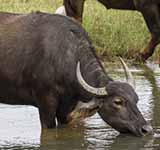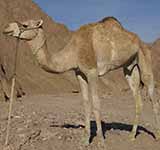The real history of making the horse pet is unknown. Some believe that 7,000 years ago, Aryan raised the horse for the first time near Southern Russia.
2. Honey Bee
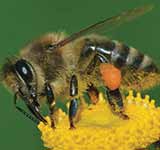
3. Chicken
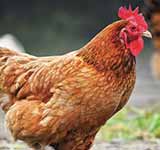
The rooster and hen (Gallus gallus domesticus) is the subspecies home of the species Gallus gallus, a kind of bird galliforme the family Phasianidae from the Southeast Asia. Common names are: rooster for the male, hen for the female, and chicken for the subadults. It is the most numerous bird on the planet, since it is estimated that the number of copies exceeds 16 billion. Roosters and chickens are raised primarily for their meat and eggs. Their feathers are also used and some varieties are raised and trained for use in cockfights and as ornamental birds. It is an omnivorous bird. Their life expectancy is between five and ten years, depending on the race.
4. Donkey

The donkey or ass is an animal pet of the family of equids. The African wild ancestors of the donkeys were domesticated for the first time in the early 5th millennium BC., practically while the horses of Eurasian, and since man have been used as pack animals and like mount. The appearance of agricultural machinery has meant a considerable decrease in their populations. Donkeys vary considerably in size. Most domestic donkeys have a size that ranges between 0.9 and 1.4 m to the cross, although there are larger varieties such as Andalusian-Cordoba, and Zamorano-Leon (which can exceed 1.6 m), and the mammoth donkey (whose largest individual came to measure 1.73 m) or the Catalan donkey (which reaches 1.65 m). The coloring and length of their hair is also very variable. Its most common color is gray in all its tones, reaching black and white, and brown tones are also common. They often have lighter or white-colored fur around the nose, the periocular area and the belly, and often have two dark cross-shaped stripes on their backs. Their mane is shorter than those of the horses, so they remain curled instead of falling on the neck.
5. Sheep
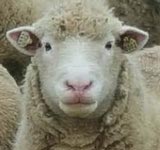
The relationship between sheep and human has been since the beginning. Sheep rearing is an ancient business. Shepherds receive lambs from the sheep every year.
6. Yak

The yak is a large species of domestic ruminant with long fleece of the Himalayas. The female yak is called dri or drimo by Tibetans and nak by sherpas. The domestic yak is used as a beast of burden (a yak carries about 130 kilograms), as a mount, provides wool (with which one makes clothes, felt and ropes), leather, meat (air dried cold and dry, smoked, with many flavors including five flavors, spicy, caraway, etc.), milk (in natural or fermented form), butter (yak butter) and cheese. In addition, their dried dung is a very used fuel. The dzo hybrid from the cross between a yak and a cow, replaces yak beautifully at lower altitudes, as pack animals and for field work. In China, Kazakhstan, Kyrgyzstan and in the region of Pamir in Pakistan people practice yak races. Other sports are practiced with the yak, like yak polo and skiing with yak. Several breeders have established yak herds in the United States and Europe, including Germany and Switzerland. There are 12 to 14 million domestic yaks.
7. Zebu
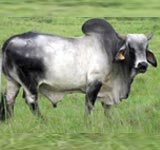
Zebu is a breed of cow from the Indian subcontinent, which is a type of cattle. This breed is identified with the fat hump, hanging ears and gallbladder in its shoulder.
8. Cow
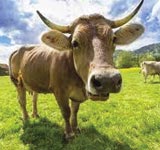
The cow is a mammal artiodactyla of the family of the bovidae with a robust body, with a height of 120-150 cm and a weight of 600-800 kg.
9. Alpaca

10. Domestic Bactrian Camel
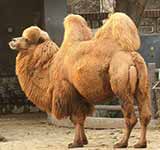
For a long time, scientists believed that the domestic population of the Bactrian camel was a direct descendant of the same taxon to which the few herds of wild camels that still survived in central Asia belonged. That is why this domesticated taxon, which was already scientifically named Camelus bactrianus, became known as Camelus bactrianus bactrianus, and the wild herds were baptized with the name of Camelus bactrianus ferus. Subsequently, in 2003, following the International Zoological Nomenclature Commission, both taxa were renamed Camelus ferus ferusin the case of the wild Bactrian camel, and Camelus ferus bactrianus for the domestic Bactrian camel, giving priority to the wild taxon.
11. Domestic Duck
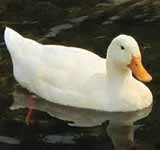
12. Domestic Goose

13. Domestic Guineafowl
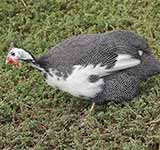
14. Domestic Pig
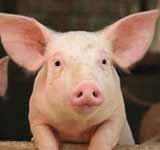
The adult domestic pig has a heavy, rounded body, comparatively long and flexible snout, short hoofed legs (four toes), and a short tail. The thick but sensitive skin is covered in part with coarse bristles and exhibits a wide variety of colors and patterns. Despite their appearance they are agile, fast and intelligent animals. Adapted by selection for meat production, as they grow and mature quickly, they have a short gestation period of about one hundred and fourteen days (three months, three weeks and three days), and can have very large litters. They are herbivores in the wild because they have a jaw prepared for vegetables. In their domestication they are omnivores and they are also given meat, always minced, but they consume a great variety of vegetables and organic remains that contain proteins. In addition to meat, the skin (leather) of the pig is also used to make suitcases, footwear and gloves, and the bristles to make brushes. They are also a primary source of saturated edible fat, although breeds that produce lean meat are currently preferred. In addition, they provide quality raw material for the production of ham.
15. Domestic Turkey

The dromedary or Arabian camel (Camelus dromedarius) is a species of artiodactyl mammal of the Camelidae family. It is similar to the Bactrian camel (Camelus ferus), which is differentiated by its generally shorter coat, less robust body and the presence of a hump instead of two. Subspecies are not recognized.
17. Gayal

18. Goat

19. Llama
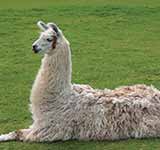
20. Ox

21. Water Buffalo
